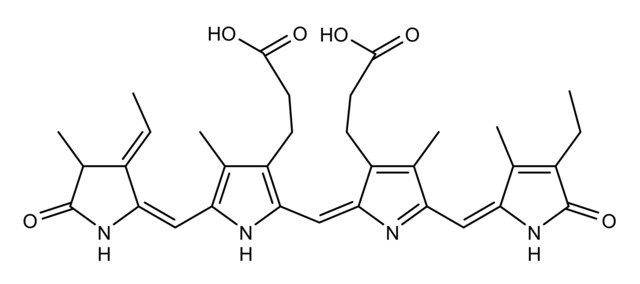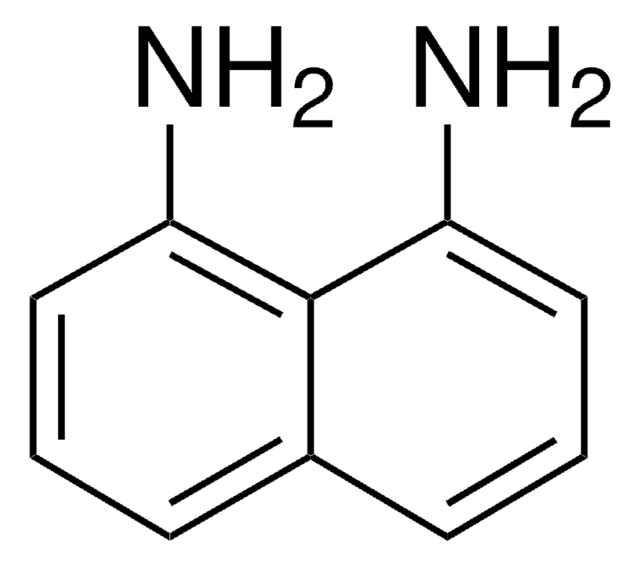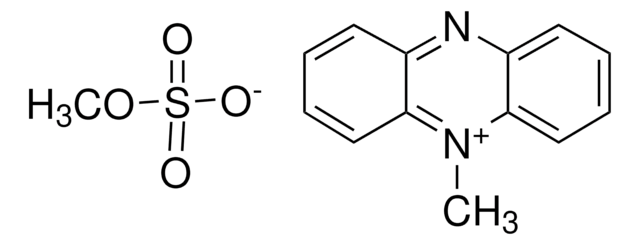R9532
Pyocyanin, Ready Made Solution from Pseudomonas aeruginosa
5 mg/mL in DMSO
Synonyme(s) :
5-Methyl-1(5H)-phenazinone, Pyocyanine, Sanasin, Sanazin
Se connecterpour consulter vos tarifs contractuels et ceux de votre entreprise/organisme
About This Item
Formule empirique (notation de Hill):
C13H10N2O
Numéro CAS:
Poids moléculaire :
210.23
Numéro MDL:
Code UNSPSC :
12352200
ID de substance PubChem :
Nomenclature NACRES :
NA.77
Produits recommandés
Essai
≥98% (HPLC)
Niveau de qualité
Forme
DMSO solution
Concentration
5 mg/mL in DMSO
Conditions d'expédition
dry ice
Température de stockage
−20°C
Chaîne SMILES
CN1c2ccccc2N=C3C(=O)C=CC=C13
InChI
1S/C13H10N2O/c1-15-10-6-3-2-5-9(10)14-13-11(15)7-4-8-12(13)16/h2-8H,1H3
Clé InChI
YNCMLFHHXWETLD-UHFFFAOYSA-N
Description générale
Pyocyanin is a secondary metabolite, which is produced by Pseudomonas aeruginosa.
Application
Pyocyanin has been used:
- To disable the ability of forkhead box A2 (FOXA2) to regulate goblet cell hyperplasia and metaplasia (GCHM) and mucin expression.
- To activate nuclear factor (erythroid-derived 2)-like 2 (NRF2) through the reactive oxygen species (ROS)-inducible epidermal growth factor receptor (EGFR)-phosphoinositide 3-kinase (PI3K) cellular signal transduction pathway and its downstream effectors.
- To stimulate Pseudomonas aeruginosa PAO1 cell line adhesion and invasion in human lung carcinoma A549 cells via reactive oxygen species (ROS) production.
Actions biochimiques/physiologiques
Pyocyanin, a redox-active phenazine, is an electron receptor, which stimulates redox cycling in bacteria, liver cells, and human epithlial cell lines. It enhances oxidative metabolism, which increases the formation of intracellular reactive oxygen species (ROS) via reduction of NADPH. Pyocyanin also increases the release of the neutrophil chemoattractant IL-8 by airway epithelial cells both in vitro and in vivo. This involves signal transduction pathways that include oxidants, protein tyrosin kinases and MAP-kinases. IL-8 secretion by these cells is in synergy with inflammatory cytokines. Pyocyanin accelerates neutrophil apoptosis in vitro. Mice infected with a pyocyanin-deficient strain of P. aeruginosa showed elevated levels of neutrophils and neutrophil chemokines and cytokines, as well as compromised bacterial clearance from the lungs compared with mice infected with a wild type strain. This suggests that pyocyanin production by P. aeruginosa suppresses the acute inflammatory response by pathogen-driven acceleration of neutrophil apoptosis and by reducing local inflammation, and that this is advantageous for bacterial survival.
Code de la classe de stockage
10 - Combustible liquids
Classe de danger pour l'eau (WGK)
WGK 1
Point d'éclair (°F)
Not applicable
Point d'éclair (°C)
Not applicable
Faites votre choix parmi les versions les plus récentes :
Déjà en possession de ce produit ?
Retrouvez la documentation relative aux produits que vous avez récemment achetés dans la Bibliothèque de documents.
Les clients ont également consulté
Pseudomonas aeruginosa pyocyanin activates NRF2-ARE-mediated transcriptional response via the ROS-EGFR-PI3K-AKT/MEK-ERK MAP kinase signaling in pulmonary epithelial cells
Xu Y, et al.
PLoS ONE, 8(8), e72528-e72528 (2013)
Nuclear protein HMGN2 attenuates pyocyanin-induced oxidative stress via Nrf2 signaling and inhibits Pseudomonas aeruginosa internalization in A549 cells
Liu K, et al.
Free Radical Biology & Medicine, 108(8), 404-417 (2017)
Pyocyanin-induced mucin production is associated with redox modification of FOXA2
Hao Y, et al.
Respiratory Research, 14(1), 82-82 (2013)
Theerthankar Das et al.
PloS one, 7(10), e46718-e46718 (2012-10-12)
Bacterial adhesion and biofilm formation are both dependent on the production of extracellular polymeric substances (EPS) mainly composed of polysaccharides, proteins, lipids, and extracellular DNA (eDNA). eDNA promotes biofilm establishment in a wide range of bacterial species. In Pseudomonas aeruginosa
Gee W Lau et al.
Trends in molecular medicine, 10(12), 599-606 (2004-11-30)
Pyocyanin (PCN) is a blue redox-active secondary metabolite that is produced by Pseudomonas aeruginosa. PCN is readily recovered in large quantities in sputum from patients with cystic fibrosis who are infected by P. aeruginosa. Despite in vitro studies demonstrating that
Notre équipe de scientifiques dispose d'une expérience dans tous les secteurs de la recherche, notamment en sciences de la vie, science des matériaux, synthèse chimique, chromatographie, analyse et dans de nombreux autres domaines..
Contacter notre Service technique









